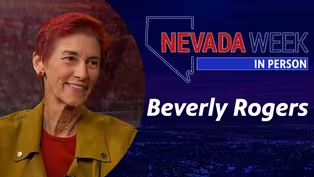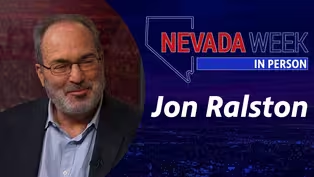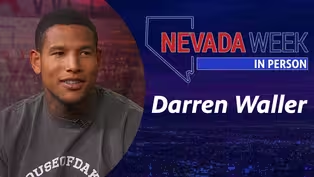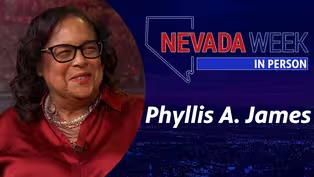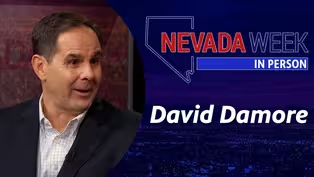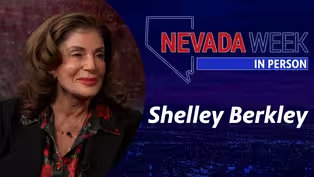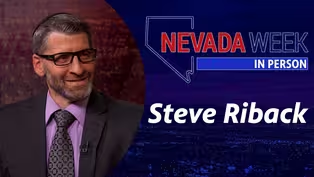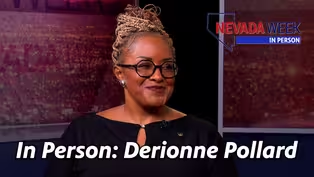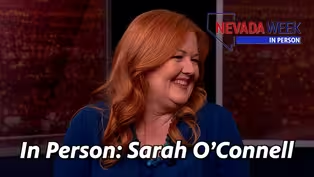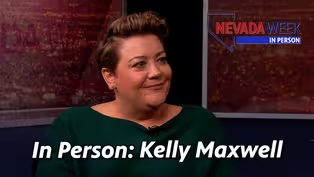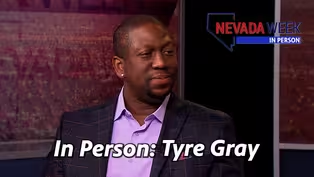
Nevada Week In Person | Mike Smith
Season 1 Episode 52 | 14mVideo has Closed Captions
One-on-one interview with Las Vegas Sun political cartoonist Mike Smith.
One-on-one interview with Las Vegas Sun political cartoonist Mike Smith.
Problems playing video? | Closed Captioning Feedback
Problems playing video? | Closed Captioning Feedback
Nevada Week In Person is a local public television program presented by Vegas PBS

Nevada Week In Person | Mike Smith
Season 1 Episode 52 | 14mVideo has Closed Captions
One-on-one interview with Las Vegas Sun political cartoonist Mike Smith.
Problems playing video? | Closed Captioning Feedback
How to Watch Nevada Week In Person
Nevada Week In Person is available to stream on pbs.org and the free PBS App, available on iPhone, Apple TV, Android TV, Android smartphones, Amazon Fire TV, Amazon Fire Tablet, Roku, Samsung Smart TV, and Vizio.
Providing Support for PBS.org
Learn Moreabout PBS online sponsorshipMore from This Collection
Nevada Week In Person goes beyond the roundtable discussion of Nevada Week with guests for a more casual conversation about their personal passions, new projects and compelling stories that are overlooked in the flurry of the news cycle.
Nevada Week In Person | Beverly Rogers
Video has Closed Captions
One-on-one interview with Rogers Foundation chair Beverly Rogers. (14m)
Nevada Week In Person | Jon Ralston
Video has Closed Captions
One-on-one interview with The Nevada Independent CEO Jon Ralston. (14m)
Nevada Week In Person | Darren Waller
Video has Closed Captions
One-on-one interview with Las Vegas Raider tight end Darren Waller. (14m)
Nevada Week In Person | Phyllis A. James
Video has Closed Captions
One-on-one interview Phyllis A. James. (14m)
Nevada Week In Person | David Damore
Video has Closed Captions
One-on-one interview with Chair of the Department of Political Science at UNLV David Damor (14m)
Nevada Week In Person | Shelley Berkley
Video has Closed Captions
One-on-one interview Senior Vice President for Touro University Shelley Berkley. (14m)
Nevada Week In Person | Liz Ortenburger
Video has Closed Captions
One-on-one interview with SafeNest CEO Liz Ortenburger. (14m)
Nevada Week In Person | Steve Riback
Video has Closed Captions
One-on-one interview with Las Vegas Metro Police Lieutenant Steve Riback. (14m)
Nevada Week In Person | DeRionne Pollard
Video has Closed Captions
One-on-one interview Nevada State College President DeRionne Pollard. (14m)
Nevada Week In Person | Sarah O’Connell
Video has Closed Captions
One-on-one interview with Director of Eat More Art LLC Sarah O’Connell. (14m)
Nevada Week In Person | Kelly Maxwell
Video has Closed Captions
One-on-one interview with Baby’s Bounty Executive Director Kelly Maxwell. (14m)
Nevada Week In Person | Tyre Gray
Video has Closed Captions
One-on-one interview with Nevada Mining Association President Tyre Gray. (14m 1s)
Providing Support for PBS.org
Learn Moreabout PBS online sponsorshipA self-described equal opportunity offender, Mike Smith, an award winning, nationally syndicated editorial cartoonist based in Las Vegas, joins us this week for Nevada Week In Person .
♪♪♪ Support for Nevada Week In Person is provided by Senator William H. Hernstadt.
-Welcome to Nevada Week In Person .
I'm Amber Renee Dixon.
His political cartoons have animated the pages of the Los Angeles Times , Newsweek and USA Today , and at the Las Vegas Sun is where his drawings have poked fun and held the powerful accountable since 1983.
Mike Smith, thank you for joining us for Nevada Week In Person .
(Mike Smith) Thank you, Amber, for having me.
-You are a graduate of Loyola Marymount University, a Jesuit Catholic University in LA.
And in an interview with that university's magazine, it was revealed that from some sketches in your mother's garage when you were a child, even back then you were opinionated.
What were you drawing as a child that revealed that quality about you?
-And that's a really good question.
You know, going back and looking at some of those sketches that I did as a-- as a child, I was even surprised by the fact that they had a point of view.
And although I wasn't obviously paying much attention to the news at that time as a-- as a child, there was still something going on in the back of my mind that made me want to say something in the art that I was doing.
-Do you remember an example by chance?
-I remember that a lot of those drawings had to do with cars and trains, which is probably pretty standard for that, for that age group.
-Yeah.
-But in terms of politics, no.
I think it was a little too early at that point for anything about politics.
-And you were drawing cars, which perhaps led to your interest in NASCAR, which I hope we're gonna get to talk about.
But that Jesuit upbringing, how would that impact your development into this career?
-Well, I went to a Jesuit All Boys High School and then on to Loyola, which was a Jesuit university.
And the Jesuits were always challenging you to think for yourself and to take the road less traveled and to try to make a difference in the world as best you can.
And those were all things that kind of stuck with me as a student.
And that philosophy, I think, meshed perfectly with drawing editorial cartoons and trying to make commentary about things in the news, injustices in the world, and of the things that, you know, need to-- that readers need to pay attention to.
-An example of that line of thinking would be a cartoon you did about the CDC.
The bubble reads, "Centers For Distributing Confusion..." -Right.
-Do you remember what was happening around that time?
I mean, I know it was COVID-- -Absolutely.
- --but your process for developing that cartoon?
-Well, each day I do a lot of reading.
And reading is really the fuel for the creative process.
You've got to really absorb a lot of information to get the wheels of creativity turning.
And of course, the criticism of the CDC at the point in which I did that cartoon was very high.
And a lot of people felt that the messages coming from the CDC were confusing.
So that was a natural story, a natural headline at the time to do a cartoon on.
-You had to think of that acronym, though.
-Right, yeah.
Well, it's just a matter of brainstorming, and things come into your head as you're brainstorming, and eventually, a light goes off and an idea will work.
-You were telling me off camera each day you come up with about three sketches.
-Yeah.
-And by what time are you running those by your editors to see if anything clicks?
-I usually start early, 7:30 in the morning, and maybe a little bit of television to get started.
But then it's mainly reading and reading, you know, obviously, the Sun , New York Times , Washington Post , Politico , anything that can help me understand what's going on in the world in that day, and then it's just a matter of brainstorming.
I actually call it "brain mapping," where you have a blank piece of paper, and you maybe write a subject topic in the center of the piece of paper.
And then from that, brainstorm other words and phrases that come into your mind that are related to that topic that you've chosen.
And eventually the ideas come.
So you know, I may even have five ideas a day, but that doesn't mean that all five of them are good.
So I usually try to boil it down to three ideas that I can show the editors in the Sun newsroom and get some feedback from, as to which cartoon I should draw for the next day's paper.
-And what are you looking for from them?
What do you not want them to be doing when they're looking at it?
-I don't want them to look confused.
I don't want them to be scratching their head.
I mean, if they do that, then I know that's an idea that belongs in the trash and I need to move on.
I just want a reaction, you know?
I want them to like it, to raise eyebrows, a chuckle, any kind of response that shows that the idea works.
Just because I have an idea that works for me doesn't necessarily mean that it's going to work for everybody else.
So I need to have a little bit of feedback from the editors in the newsroom as to what ideas work.
And they're very good at that.
I'm very fortunate that they-- that my editors give me good feedback every day.
-It's not always humor that the cartoons invoke.
You were quoted by 8 News Now saying that when the CHALLENGER exploded in 1986 and the 911 terrorist attacks came in 2001, it was time to capture the moment, that you don't always enjoy drawing about those subjects but that there are important things that need to be addressed.
Why are they-- Why do they need to be addressed?
-Well, they need to be addressed because they're news stories of tremendous impact and importance to the world and the community.
But stories that are tragic are the most difficult cartoons to draw because you have to be extremely conscious of the sensitivity of the story.
And that means that your ideas have to be extremely clear and concise so that there might not be any confusion or any kind of misrepresentation or misunderstanding that somebody could take from your idea.
So they're very-- They're very difficult to do, but you have to do them.
-I mean, but you very well could just leave the coverage to the journalists and not put it in a cartoon.
-You could.
-But you feel an obligation to do that?
-Well, it's my job.
I mean, it's my job to draw cartoons on the major events of the day and to express an opinion about the major events of the day.
So it would kind of be-- It would be a mess of me to not pay attention to something as important as say, the CHALLENGER tragedy.
-One that makes me think of what you were just talking about is an abortion cartoon in which a woman-- and we're going to be showing these --is reading about the abortion announcement and says, "If I were a gun, I would have more rights."
-Right.
-That kind of-- That hurts.
-Mm-hmm.
-What emotions did it invoke in you?
What was your process for that one?
-Well, you know, sometimes the best ideas come out of frustration and maybe even some anger at what's going on in the world in the stories that are being covered.
And I think that that was a subject matter that I felt very motivated about and actually struggled that day a lot to come up with ideas.
And if I remember correctly, there was something that I read somewhere that related what was going on with abortion to what's going on with guns in this country.
And that was the spark that made that idea happen.
-What kind of reaction did you get to that, if any?
-I don't think I got any reaction to that, actually.
Reaction?
Reaction has changed.
I mean, when I first started in this business, people would write letters, and they would challenge you on the point that you had made in your art.
People don't do that as much anymore, unfortunately.
Now a lot of the reaction is personal attacks, which is a shame because you're gonna-- I'm going to interact less with readers if they're making personal attacks, as opposed to if they wanted to have a conversation about the point of the cartoon.
-You've drawn many Presidents over your tenure.
Who has been the most favorite?
Who's been the most difficult to draw?
-I think that Bill Clinton was the easiest President to draw and probably the most fun to draw.
And I think Barack Obama was probably the hardest President to draw.
-What about him was so difficult?
-He didn't have any-- Usually in drawing a caricature of someone, you take a certain outstanding feature and exaggerate them in order to make the person recognizable.
And Barack Obama didn't have a lot of, you know, features that were really outstanding; whereas, Bill Clinton you could probably at the time just concentrate on his gels and the hair, and you'd pretty much have his caricature completed.
Ronald Reagan was also a great one to draw, because you could pretty much just concentrate on that hair.
As long as you got that hair down, it would always look like Ronald Reagan.
-Speaking of hair, how difficult was drawing former President Donald Trump's hair?
-It was difficult because that hair always seemed to be changing.
And I think if you look at my cartoons over the four years that Trump was President, you'll see that the hair in the cartoons changed quite a bit.
But that's natural.
I mean, with any character, if you look at the beginning of an administration, the caricature that you draw in the beginning and the character that you're drawing four years later, is much different.
It evolves.
-Has it been difficult-- Well, you've talked about him as a goldmine of content during his presidency.
-Right.
-I imagine it continues even as he's out of office.
-It does.
It does, but sometimes I find myself saying, I'm not doing a cartoon on Donald Trump today because, you know, the Trump news cycle is constant.
And in previous administrations, you could pick a headline, a major headline from the day, and concentrate on that and come up with your ideas and complete a cartoon on that.
During the Trump administration, things could change hour to hour; and you might have an idea that you're going to go with, and then the news changes, and I would find myself starting the day all over just so I would be timely.
-I am struck when I see the top read articles in different publications and that there's an editorial cartoon often-- -Sure.
- --among the top.
What is behind that?
Why the desire?
-People like editorial cartoons.
I mean, people like cartoons, in general.
And it's a unique form of communication.
It's not like anything else that's in the newspaper, really, because it is a quick read.
I mean, it takes three to five seconds to understand a cartoon.
And it's, it's a form of visual communication that is, you know, has always worked in print but translates very easily to online also.
-Tell me about what you do with NASCAR and why you've continued to do so.
-I've always been a NASCAR fan and kind of a car nut.
And years ago, I started doing, which was basically an editorial cartoon on NASCAR called "StockcarToons."
Well, eventually, the publication opportunities for that dried up as changes have happened in print journalism.
So I changed it into a comic strip about a character named Gearhead Gertie who's an elderly woman who's obsessed with NASCAR.
So that's, that's its current form.
-Well, you don't identify with her in any way, do you?
-No.
Well, other than-- Other than the enjoyment of NASCAR, not really, no.
-All right.
And you're also covering NASCAR, though?
You're writing, correct, or have in the past?
-I have in the past, but not very much.
That was just kind of sporadic here and there.
-All right.
One more question I think that we have time to fit in: Of the reaction that you do get from the politicians that you draw, who tends to reach out more?
Who have you been surprised by, or who's reached out to you and said, I want that; I like that?
-That's a good question, too, because, you know, my cartoons tend to be left of center.
But most of the people-- Most of the politicians that ask for my cartoons have been Republicans.
They seem to have a pretty healthy sense of humor about themselves.
And so that's always enjoyable when somebody calls in and wants a cartoon.
-Mike Smith, thank you so much for joining Nevada Week In Person.
To see more, go to vegaspbs.org/nevadaweek.
♪♪♪

- News and Public Affairs

Top journalists deliver compelling original analysis of the hour's headlines.

- News and Public Affairs

FRONTLINE is investigative journalism that questions, explains and changes our world.












Support for PBS provided by:
Nevada Week In Person is a local public television program presented by Vegas PBS
